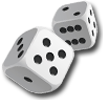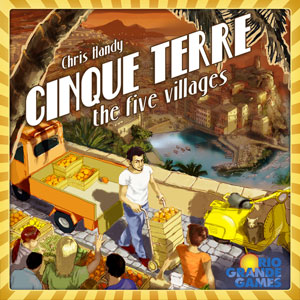



play board games
Board game reviews, strategy tips & session reports
Cinque Terre Board Game Review
 Stats:
Stats:
No. of players: 2-5
Amount of time to play: 60 min
Age requirements: 13+
Set-up time: 5 min
The Cinque Terre are five villages in Italy. In this game you must harvest produce, deliver it to the five villages and fulfill orders to score victory points.
Cinque Terre Rules Description:
The board for Cinque Terre has the five villages and three spaces where you can harvest produce. You set up the board by pulling dice from a bag for each village. The dice are color coded to match a specific type of produce. The value (one to six) indicates how much you can sell that type of produce for there. To finish setting up the board you place the produce cards on the board and flip four face-up.
You also start the game with an Order Card. There is also a deck of Order Cards you set by the board and flip the top cards face-up equal to the number of players. One of these face-up Order Cards may be claimed at the end of your turn if you have delivered the required produce to the specified villages.
On your turn you may perform three actions. The actions you can take are move up to four spaces clockwise, draw one produce card, harvest produce or sell produce.
When you draw produce cards you take one of the four face-up ones or the top one from the deck. Harvesting lets you take a produce item from the field you are in when you discard a matching produce card. You can collect any piece of produce, no matter the harvest space, by discarding a matching pair of produce cards. You may only have up to four undelivered items on your cart at any time.
When you sell produce, you instantly score VPs based on the die value for the produce in that village. If there is no die for that produce item, you score one VP. The item you sell is placed on your player board. There are eight spaces for each village on your player board. If you sell eight items to any single village you get the card for the Most Popular Vendor for that village. These are worth 8,10 or 12 VPs depending on the village.
At the end of your turn you may claim one of the face-up Order Cards. Then you take a card from top of the deck and look at it. If you want you can add it to your hand and then flip over the top one from the deck to replace the one you claimed. If you don’t want to keep that Order Card, you may use it to replace the one you claimed and take one blind from the top of the deck.
Once five total Order Cards and/or Most Popular Vendor cards have been claimed, there is one last turn and then the game is over. It can also end if two harvest spaces are depleted of all their crops. Your final score is the total of the cards you’ve claimed, your marker on the board, and your starting Order Card. Its value can be up to 30 VPs if totally fulfilled but it will lose you VPs if not totally fulfilled. Likewise any secret Order Cards you took from the pile can gain or lose you points based on their fulfillment.
Quick Review of Cinque Terre:
Cinque Terre is a board game that requires efficient planning and a dash of luck to win. This game combines common mechanics you will probably be familiar with making it easy to learn and teach.
The art and components for the game are really nice. Everything is very bright and looks good. The rules are pretty easy to read and follow. Although calculating your Staring Order Card value is confusing.
This game really rewards efficiency and good planning. You need to be able to look a few turns ahead to do well. This might take a few turns to get down, but once you get into the flow of the game it can be fun (if you are into that sort of thing).
I really like that Cinque Terre has multiple paths to victory. Do you try to fulfill Order Cards? Or simply sell produce to the highest bidder? You can even just try to get the Most Popular Vendor cards for each village or try a mix of all these strategies.
The game does have its issues though. The theme feels pasted on and as a whole the game is a bit dry. It just feels like work and doesn’t do anything new or innovative. Though it does make a good teaching game.
Cinque Terre would make a good game for teaching some familiar mechanics in the game. It uses a rondel, pick-up and delivery and variable resource values. If you are looking for a game with these elements you should pick it up. Also if you enjoy games that features logistics and where careful planning is rewarded, you should check this out.
Score and synopsis: (Click here for an explanation of these review categories.)
Strategy 3 out of 6
Luck 4 out of 6
Player Interaction 2 out of 6
Replay Value 4 out of 6
Complexity 3 out of 6
Fun 4 out of 6
Overall 4 out of 6

Leave a Reply